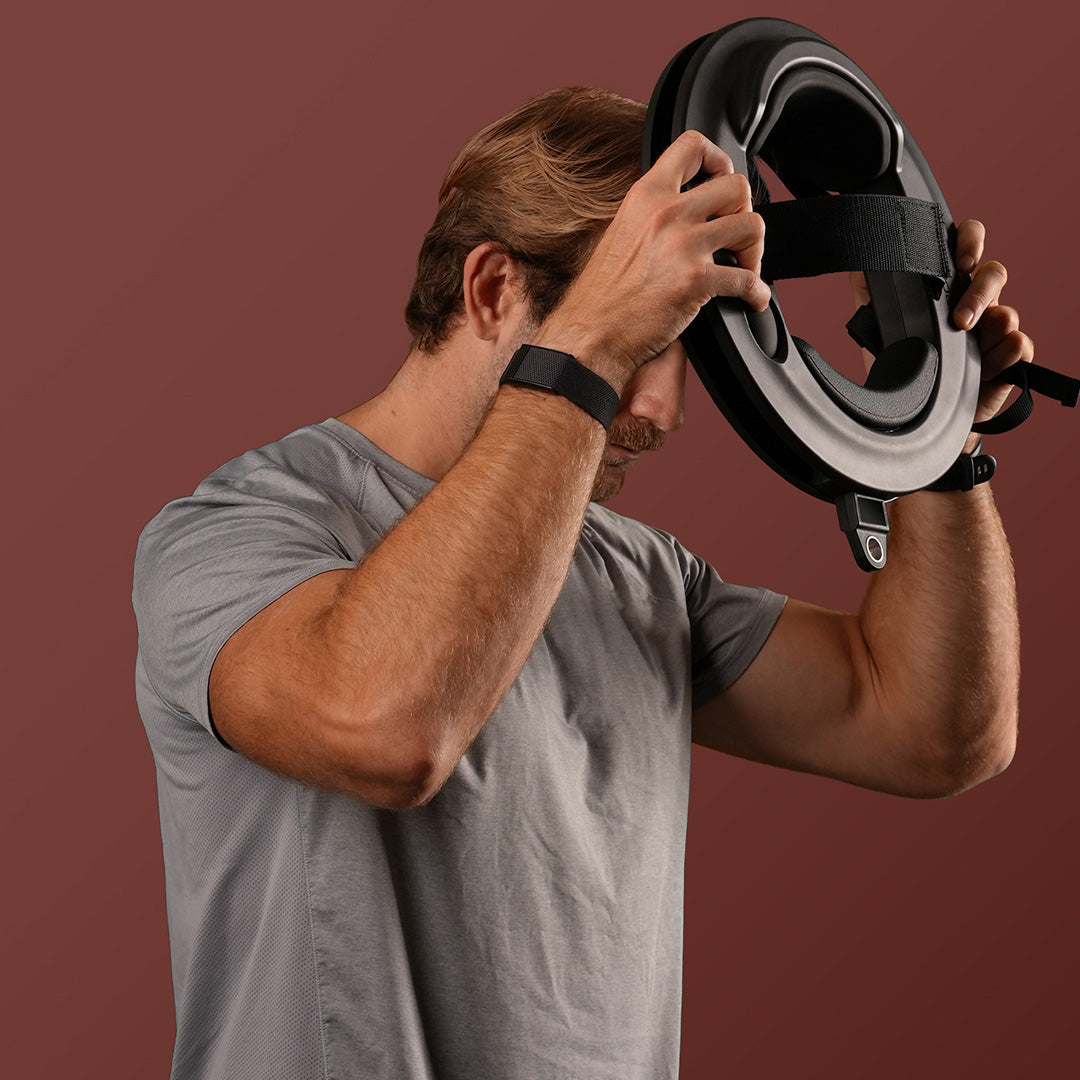If you're suffering from neck pain from golf, it can prevent you from fully enjoying something you love.
Whether your pain is persistent throughout the round or you feel it later that night when you get home, you'll not be able to really play your best or have as much fun out on the course.
This begs the question - is this golf neck pain preventable, or is a sore neck or upper back pain from golf just an inevitability from swinging the clubs regularly?
We're here to tell you that you can in fact enjoy one of your favorite pastimes without stressing about injuring yourself or feeling sore. There are a few reasons you might be dealing with an injury or soreness - and we're going to cover them today and help you get back to your full form.
Then, we'll explain how you can avoid neck pain from golfing altogether with a few important exercises. Let's start by quickly looking at the anatomy of your neck and upper body during the golf swing.
Is It Normal To Have Neck Pain from Golf?
The first question you'll have if you're dealing with a sore neck from golf is whether or not it's normal. Your hips might get a bit sore after 18 holes, as will your shoulders, upper back, etc. - but what about your neck?
For the most part - you really shouldn't deal with any pain in your neck specifically from golfing. If you do, it's an indication that something is off. Maybe you're not swinging the clubs correctly.
Or, maybe you have a pre-existing neck issue that is being agitated by your golfing habit. Either way, the golf swing itself should not produce neck pain.
There are instances in which you could develop some sort of muscle strain - but this is typically something you feel right away after tweaking your neck or upper back. You'll know something happened right away.
Throughout this article - we're talking about general soreness, pain, and discomfort as a result of overuse. If you believe you've suffered some sort of serious injury like a muscle strain - we recommend seeking professional help.
Can Golf Cause Neck Injury?
New golfers in particular are the most at risk for developing neck problems - because they aren't used to the motor patterns involved in the sport. It's possible that if you're just starting out, you could develop tension and pain in your neck after hours and hours of swinging a club. The twisting of your body can put stress on your delicate neck muscles.
How Do You Prevent Neck Pain From Golf?
After your body adapts to the movement involved in golf, you shouldn't have any neck pain. If you do - one of three things could be happening:
- You're not swinging the club properly
- You've aggravated an existing injury in your neck
- You have a weak neck
It could be a combination of these three things. Let's explain how you can correct each of them.
Work On Creating A Natural, Safe Golf Swing
One of the first things you should look at if you are suffering from pain in your neck from golfing is your swing pattern. Poor swing mechanics can wreak havoc on your musculature and contribute to a stiff neck.
To evaluate your swing, we recommend recording yourself from a few different angles to get the full picture of what could be happening.
First and foremost, ensure your cervical spine isn't out of alignment when you swing the club. This means that your head is excessively pushed forward. If this is happening to you, it'll place tons of stress on the tiny muscles in your neck which are forced to stabilize your head in that compromised position.
Another thing to look at is your club path during the swing - are you overreaching? If you're standing too far away from the ball, you'll have to overcorrect in your swing to make contact - and again, this will place stress on the neck and result in soreness or discomfort.
Warming Up Prior To Playing Or Practicing
One of the main reasons why your neck muscles are so tight could be a lack of warmup. Whether you uncover any issues in your golf swing or not - we still recommend starting to incorporate a dynamic warmup before playing a round at the course or hitting a bucket at the range.
We want to put some emphasis on the dynamic aspect - your goal should be to warm up the muscles involved in the golf swing in a natural, sport-specific manner. Getting blood into these muscles will help cut back on the chance of injury or tightness you feel.
If nothing else, warming up will certainly make you a better golfer - so perform a few movements to get loose before you even swing at a ball. Get some rotations in to warm up your spine and stretch out your shoulders.
If you feel the tension in your neck in particular, here are some warmup movements you can incorporate to get the blood flowing in that area:
- Head extension & flexion
- Look left, look right
These two movements can be performed with nothing more than the weight of your head and should be plenty to get your neck feeling warm
Train Your Neck To Prevent Injury Or Pain From Golfing
A stronger neck is one that's harder to injure - which is why we highly encourage all athletes to actively train their neck.
Not only will you create a stronger neck by routinely training it, but you'll be able to actively increase your mobility and stability, too.
This means you'll be better equipped to perform your golf swing. But what exercises should you start with? What equipment do you need? Let us break it down for you.
Start By Grabbing Any Neck Training Equipment You Need
While the warm-up movements we just discussed can be performed with no supplies or equipment at all, actually training your neck will be a bit more robust. You'll need some form of resistance - and you'll need to increase that resistance week after week to keep the progression going and continue to improve.
You don't need anything crazy - like the machines you've seen at your local gym - to train your neck, fortunately. You can get started at home with something as simple as a neck harness and resistance bands or weights if you already have them.
After putting the harness on, you can attach your resistance bands or weights and perform these movements - you'll want to start light and work your way into higher weights. Always ensure you've perfected the technique and movement pattern before adding any resistance - again, strengthening your neck muscles from different angles is key to achieving better neck posture and balance.
If you're a serious athlete and looking to take your golf game even more seriously - you'll need to take your training and recovery more seriously. If this sounds like you, it may be worth investing in the Iron Neck instead.
This is the #1 choice for anyone seeking exercise equipment for neck workouts. This offers a far more dynamic workout and unlocks 360-degree training. Head over to the site and find out for yourself why the top athletes and coaches around the planet are using it in their own regimen! For now, let's talk about specific exercises.
Which Exercises Are Best For Preventing Golf Neck Pain?
To start off our list of exercises for neck pain from golfing, we want to focus on creating stability in the neck. You can simply attach your neck harness or Iron Neck and step back to get tension on it.
Once you have tension and feel your head being pulled forward, simply keep your neck packed and prevent it from being pulled - then, you can turn your body 180 degrees and do the same thing - this targets muscles in both the front and back of your neck. Then, hit the sides, too.
From there, we're ready to perform more specific movements to strengthen or rehab your neck. You can read our full guides on the best neck posture exercises, neck exercises for mass, or the best exercises for a pinched nerve in the neck. However, here are some of our favorites to point you in the right direction:
LOOK LEFT, LOOK RIGHT
We recommended this one as a warmup, but adding some resistance and performing it for multiple sets can really strengthen the lateral muscles on your neck.
This is one of the top neck exercises for golfers because it emulates the golf swing movement pattern pretty closely.
Think about it - you're looking down at your ball, you execute your takeaway, then turn your whole body around your spine throughout the swing and your head follows the ball, turning and looking up. As such, we highly recommend building strength and stability within this movement.
One important caveat is to train both the right and left sides of your neck - otherwise, you'll end up with imbalances that could lead to more pain and discomfort.
PROTRACTION & RETRACTION
Two more basic movements that you can perform with your Iron Neck device or harness are protraction and retraction.
These are essential for helping you keep your neck packed and in proper cervical alignment through your golf swing.
Start by getting tension on your harness or Iron Neck, and then let your head drift forward in a "forward head posture" look - yes, it's pretty unsightly! Then, slowly bring your head back into alignment (the starting position).
Perform a few sets here, and then turn your body away from the anchor point - so the tension now comes from behind you.
Extend your nose as far forward as possible, and then slowly allow your chin to tuck back in. These two movements will go a long way in preventing injury throughout the entire neck - and can even eliminate upper back pain from golf!
LOCKED BODY NECK TURN
One final movement we want to share is the locked-body neck turn. This is another movement that has similar patterns to your golf swing - making it a great addition to your training.
As with all these movements start by getting tension on the band. Here though, you'll want to step out from your anchor point laterally, so the tension is coming on the side of your neck rather than the front or back.
Take an athletic stance - similar to your swing. Clasp your hands in front of your chest, and allow your torso to rotate as far left and right as possible while keeping your chest and head in vertical alignment - this is the key component in this movement.
This will not only strengthen your neck and upper body, but it will also create more explosive strength that carries over to your swing - getting you more distance on your shots! After all, strength is one of the main benefits of neck training.
Final Thoughts On Neck Pain From Golf
Before we wrap up our guide on neck pain from golf, we want to encourage you to check out our video resources on these three movements - along with tons of other great exercises worth trying.
Visually seeing these movements performed will go a long way in helping you perfect your technique quickly. As with any new exercises, start slow and focus on getting the movement perfected before adding any load.
By evaluating your swing pattern, incorporating a dynamic warm-up, and actively training your neck - you will drastically cut back on your chance of neck injury during golf - while eliminating upper back pain from golf, too.
If you're actively battling pain and discomfort, these movements will be even more essential in helping you recover and get back to 100% on the course. You can also take a more active approach to calming your agitated neck muscles. For example, learning how to massage neck muscles can get tight areas to release and provide much-needed relief. Relaxing neck muscles is just as important as strengthening them, after all.
Armed with all this information, you should feel more confident in preventing neck pain from golf in the future going forward. Just remember to warm up properly and recover correctly after your training sessions on the range or on the course. And, by increasing neck flexibility and strength, you can make golf-related neck pain and upper back pain from golf things of the past! It's time to start playing golf pain-free once and for all.











